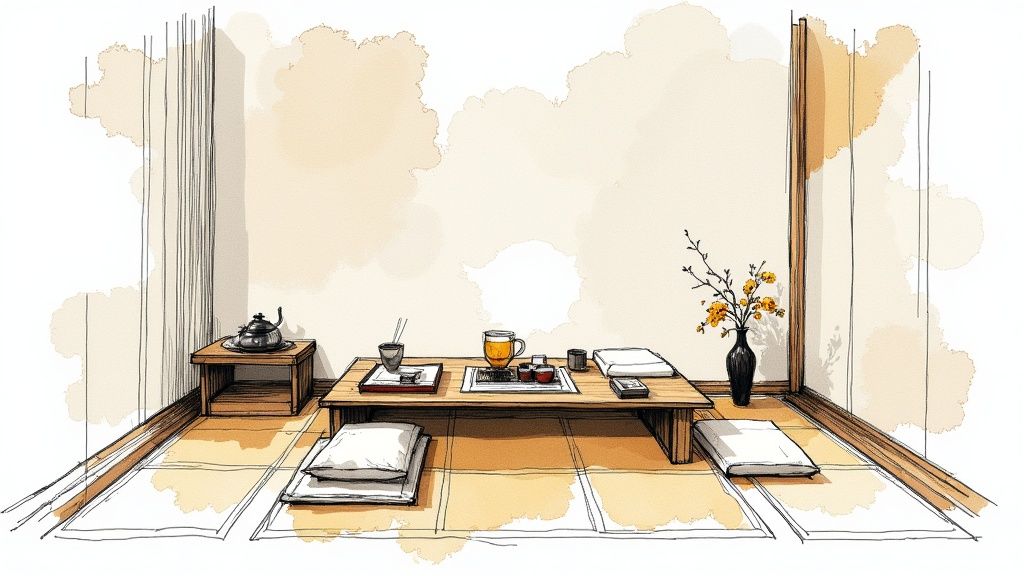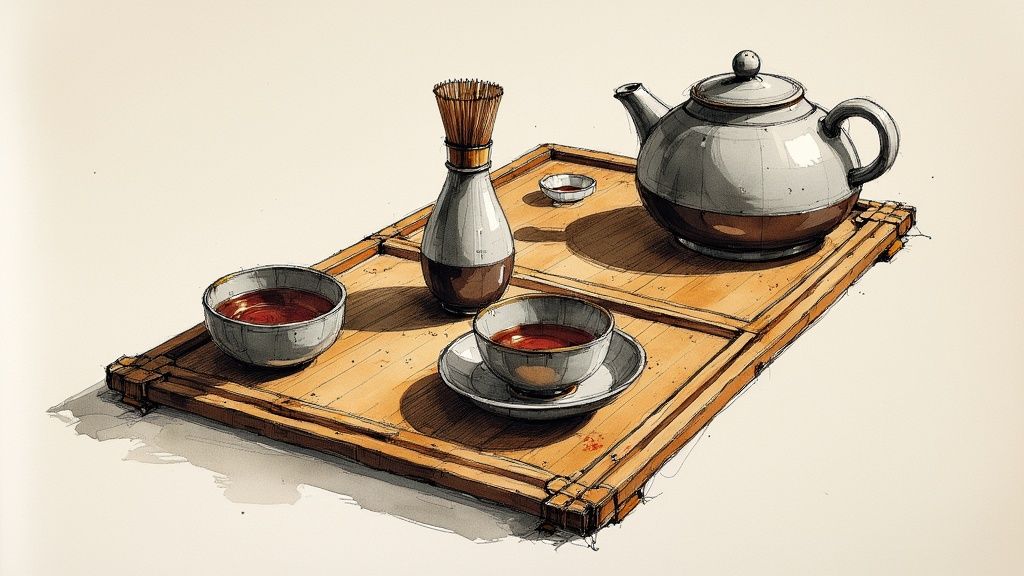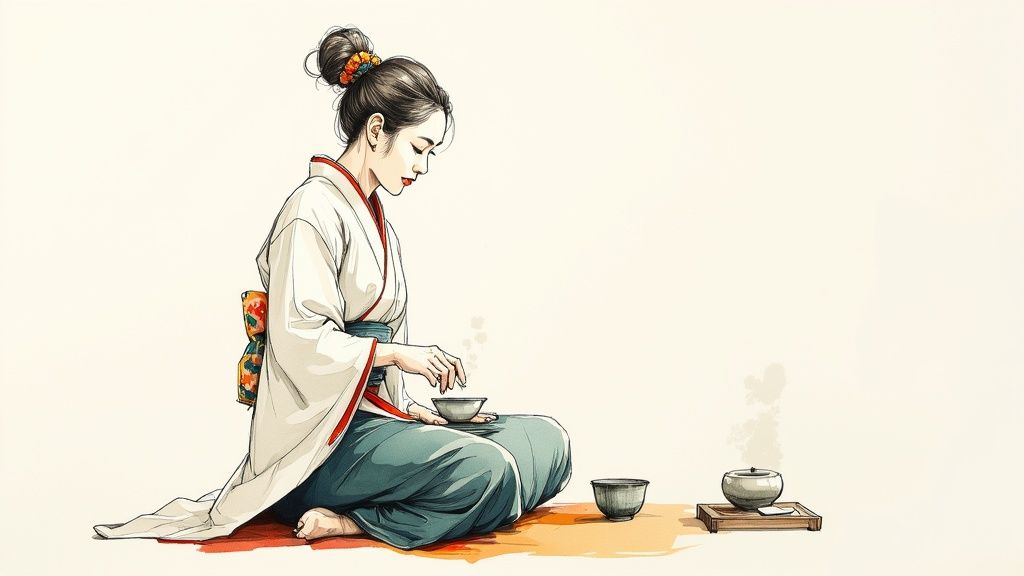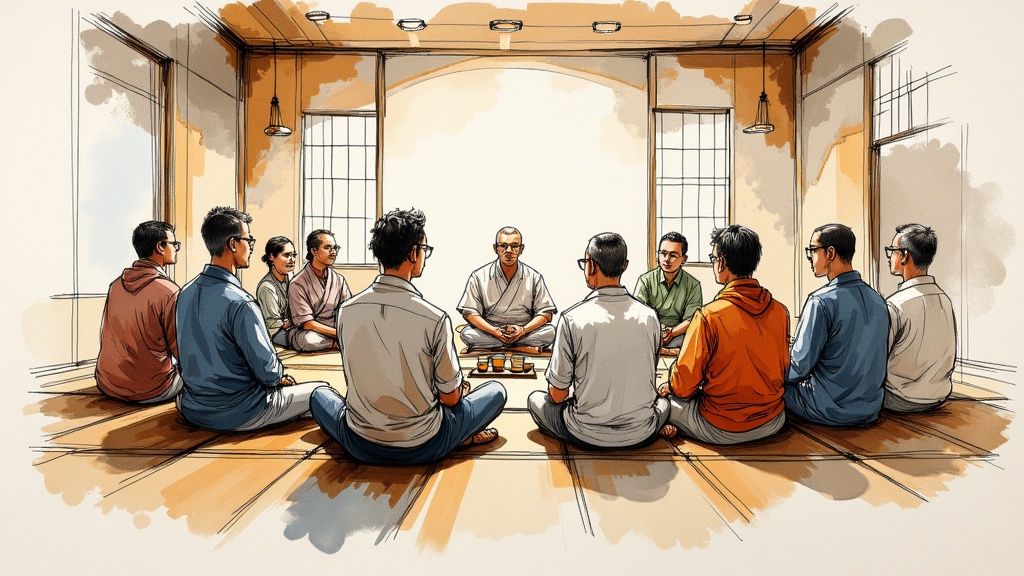How's this?
The Living Legacy of Japanese Tea Culture

For over twelve centuries, the Japanese tea ceremony has been woven into the cultural fabric of Japan, shaping art, architecture, and social customs. From its humble beginnings to its present-day practice, this cherished ritual tells a remarkable story of how a simple act of drinking tea became a profound expression of Japanese aesthetics and values.
From Imperial Courts to Modern Practice
Tea first found its place in Japan among the elite circles of Buddhist monks and imperial courts. In 815 AD, the monk Eichū made history by serving tea to Emperor Saga, marking tea's formal entry into Japanese culture. The following year saw the establishment of tea plantations in the Kinki region through imperial decree. While tea drinking wasn't immediately widespread, these early royal connections set the stage for what would become one of Japan's most celebrated traditions.
The Buddhist and Samurai Influence
During the Muromachi period (1336-1573), Zen Buddhism deeply influenced how the tea ceremony evolved. The practice absorbed Zen principles of mindfulness and simplicity, becoming more than just a social custom – it became a path to spiritual insight. The samurai class added another dimension through tōcha, or tea tasting competitions, where warriors demonstrated their refined palates and cultural sophistication alongside their martial skills.
Sen no Rikyū: A Master's Vision
Sen no Rikyū emerged in the 16th century as a pivotal figure who gave the tea ceremony its enduring form. His introduction of wabi aesthetics celebrated the beauty found in simplicity and imperfection. This philosophy led to intimate tea houses (chashitsu) and specially crafted ceramics. The four principles he established – wa (harmony), kei (respect), sei (purity), and jaku (tranquility) – still guide practitioners today.
Matcha: The Heart of the Ceremony
The story of the tea ceremony is incomplete without matcha, the powdered green tea that Buddhist monk Eisai brought to Japan in the 12th century. Eisai's cultivation of tea in Kyoto's Uji district established a legacy of excellence that continues today. The ceremony features two distinct preparations of matcha – koicha (thick tea) and usucha (thin tea) – each offering its own unique experience and meaning within the ritual.
Through centuries of refinement, the Japanese tea ceremony has evolved from imperial gatherings to an art form that speaks to universal human experiences. For those interested in exploring this cultural treasure further, visit Journey Through Time: History of the Japanese Tea Ceremony. The ceremony's ability to bring people together in mindful appreciation continues to make it relevant in our fast-paced world.
Mastering the Four Sacred Principles

Sen no Rikyū, who deeply influenced the Japanese tea ceremony, established four key principles that guide the practice to this day. These principles – wa (harmony), kei (respect), sei (purity), and jaku (tranquility) – shape every element of the ceremony. From preparing the matcha to the subtle interactions between host and guest, these principles bring meaning and depth to each moment of this time-honored tradition.
Harmony (Wa)
The principle of harmony, wa, creates connection between everyone and everything in the tea ceremony. This extends naturally to the environment and changing seasons. The host thoughtfully selects seasonal flowers for display, chooses an appropriate scroll for the tokonoma alcove, and serves traditional sweets (wagashi) that reflect the time of year. Through these careful choices, participants experience a genuine sense of connection to nature and each other. The result is a shared appreciation for the present moment.
Respect (Kei)
Respect, known as kei, shows in the careful attention given to every detail of the tea ceremony. Each movement has meaning – from the initial bow when entering the tea room to the mindful way of handling the tea bowl. This creates an atmosphere of mutual consideration between host and guests. The tools and utensils also receive special care, cleaned thoroughly and handled gently. Even their imperfections are valued, reflecting the Japanese aesthetic of wabi-sabi that finds beauty in things that are imperfect or weathered.
Purity (Sei)
The concept of purity, sei, works on both physical and spiritual levels. Before entering the tea room, participants wash their hands – a simple act that helps clear the mind and prepare for the experience ahead. The spotless tea room and clean utensils reflect this same principle. But purity goes beyond the physical – it's about being fully present and setting aside daily concerns. This complete focus on the moment is why many consider the tea ceremony a form of "meditation in motion."
Tranquility (Jaku)
Tranquility, expressed as jaku, represents the ultimate purpose of the tea ceremony. When harmony, respect, and purity come together naturally, they create a profound sense of peace. The unhurried pace and simple surroundings of the tea room encourage quiet reflection. Both host and guests can experience this deep calm – the host through careful preparation and mindful service, the guests through respectful participation. Following these four principles transforms the tea ceremony from a simple ritual into something more meaningful – a path to inner peace and deeper understanding.
The Art and Science of Matcha Preparation
The preparation of matcha in Japanese tea ceremonies transforms a simple activity into an intricate ritual steeped in tradition. Building on the four principles discussed earlier, making matcha becomes a mindful experience that engages all the senses. Let's explore the detailed techniques needed for perfect matcha preparation, including the distinct styles of koicha and usucha, along with the key elements of temperature, timing, and essential tools.
Koicha: The Essence of Thick Tea
Koicha, which means "thick tea," produces a rich, concentrated texture similar to melted dark chocolate. This style uses a higher ratio – typically three to four scoops of matcha powder per two ounces of hot water. The preparation requires gentle, methodical whisking movements with a chasen (bamboo whisk) to achieve a smooth consistency without creating foam. This careful process makes koicha particularly special in traditional Japanese tea ceremonies, where each movement carries deep meaning.
Usucha: The Delicacy of Thin Tea
Usucha, or "thin tea," offers a more approachable everyday experience. Using roughly one scoop of matcha to four ounces of water creates a lighter, more fluid consistency. The key difference lies in the whisking technique – usucha needs quick, vigorous strokes to produce its signature frothy crema on top. This foamy layer, when done right, adds both visual appeal and a pleasing texture that enhances the drinking experience. The distinct whisking methods for koicha and usucha showcase the depth of skill needed in traditional tea preparation.
Tools of the Trade: Precision and Purpose
Every tool in matcha preparation serves both a practical and ceremonial role. The chawan (tea bowl) isn't just a container – its design often reflects seasonal themes while providing the perfect shape for whisking. The chashaku (bamboo scoop) ensures exact portions for consistent results. Perhaps most important is the chasen, carved from a single bamboo piece, which creates the distinct textures that define both koicha and usucha styles.
Temperature and Timing: The Science of Matcha
Getting the water temperature right is crucial for bringing out matcha's best qualities. Too hot, and the tea becomes bitter; too cool, and it loses its rich character. The sweet spot is around 175°F (80°C), which allows the tea's complex flavors to bloom fully. Timing matters just as much – koicha needs slow, patient whisking while usucha requires quick, energetic movements to achieve their distinctive textures.
By mastering these elements – from the specific techniques for koicha and usucha to proper tool use and precise temperature control – you show deep respect for the ceremony while creating truly exceptional tea. With practice and attention to detail, making matcha becomes both an art form and a meditative practice that enriches the entire tea ceremony experience.
Creating Sacred Space: The Tea House Experience

When you walk into a Japanese tea house, or chashitsu, you enter more than just a building – you step into a thoughtfully designed sanctuary. The tea house serves as the heart of the Japanese tea ceremony, embodying four essential principles: wa (harmony), kei (respect), sei (purity), and jaku (tranquility). Every element within creates an atmosphere that helps visitors leave their daily concerns at the door and fully immerse themselves in the present moment.
Architectural Elements: Blending Form and Function
The journey into a tea house begins with intention. Guests must bow low to enter through the nijiriguchi, a small entrance that physically requires humility. This design choice dates back centuries, when it helped establish equality among all participants regardless of their social status outside the tea house. Inside, simplicity reigns – natural materials like wood and paper dominate the space. Soft tatami mats line the floor while delicate shōji screens filter sunlight into gentle, ambient illumination that soothes the mind and spirit.
The Tokonoma: A Focal Point of Contemplation
At the heart of the tea house sits the tokonoma, a recessed alcove that draws the eye and calms the mind. This special space showcases carefully selected seasonal elements that enhance the ceremony's meaning. You might find an elegant scroll of calligraphy paired with a simple ikebana flower arrangement, creating a focal point that invites quiet reflection. Through these mindfully chosen displays, the tokonoma helps ground participants in the present season and setting.
Sen no Rikyū's Influence: Embracing Wabi-Sabi
The 16th-century tea master Sen no Rikyū shaped tea house design through his deep appreciation of wabi-sabi – finding beauty in imperfection and impermanence. His influence lives on in the tea houses' rustic materials, asymmetrical designs, and celebration of natural elements. You can see this philosophy reflected in everything from hand-formed tea bowls to uneven wooden beams. Each imperfection tells a story and reminds us to find wonder in life's fleeting moments.
Enhancing the Ceremony: Creating a Sense of Occasion
The tea house brings together countless thoughtful details that elevate the ceremony into something extraordinary. From the placement of the ro hearth for heating water to the arrangement of utensils, each element serves a purpose. The intimate space naturally draws host and guests closer, making room for meaningful connection through shared appreciation and mindful conversation. In this carefully crafted environment, participants can fully embrace the four key principles of the tea ceremony. The tea house provides a rare refuge where time seems to slow down, allowing everyone present to drop into a deeper experience of the moment at hand.
Seasonal Harmony: Nature's Role in the Traditional Japanese Tea Ceremony

At its heart, the Japanese tea ceremony celebrates our deep connection to nature and its changing seasons. Every aspect – from the sweets served to the flowers displayed – helps guests appreciate the unique qualities of each season. This mindful selection of seasonal elements creates a gentle reminder to be present and aware of nature's subtle transitions.
Wagashi: A Taste of the Season
The wagashi sweets served during the ceremony capture the essence of each season through both flavor and appearance. In spring, you might find delicate cherry blossom-shaped confections dusted with pink powder and filled with sweet bean paste that tastes faintly of sakura. Come autumn, the sweets take on deeper colors and richer flavors – perhaps shaped like maple leaves with roasted chestnut filling. These thoughtful touches help connect guests to the season through taste and visual beauty.
Utensils and Decor: Reflecting Nature's Palette
The tools and decorative elements of the ceremony also speak to nature's rhythms. Tea bowls might feature designs inspired by seasonal flowers or landscapes, while even the bamboo whisk used to prepare matcha connects to nature's cycles through its careful harvesting. In the tokonoma alcove, seasonal flower arrangements bring the outside world in – perhaps featuring early spring plum blossoms or late autumn chrysanthemums. These small details work together to ground the ceremony in the present moment.
Seasonal Variations Across Schools
Different tea ceremony schools each have their own ways of honoring the seasons. Some focus on particular seasonal flowers or sweets, while others emphasize seasonal poetry displayed on hanging scrolls in the tea room. For example, an autumn gathering might feature verses about falling leaves accompanied by arrangements of late-blooming flowers. This diversity of approaches shows how the ceremony can celebrate nature's changes in many meaningful ways.
A Deeper Connection Through Seasonal Awareness
By weaving seasonal elements throughout the ceremony, tea gatherings offer more than just a chance to drink tea together. They create space to notice and appreciate nature's ongoing cycles. The careful choice of seasonal touches – from the sweets to the flowers to the poetry – helps guests feel more connected to the natural world and to each other. This awareness of nature's rhythms gives the ceremony deeper meaning, making it a true celebration of both human connection and the beauty of each passing season.
Preserving Tradition in Modern Times
The Japanese tea ceremony's rich legacy of ritual and meaning continues to resonate deeply today. This centuries-old practice has proven remarkably resilient, even in our busy modern lives. Far from becoming obsolete, the ceremony offers something increasingly precious – a space for stillness and contemplation away from constant distractions. Let's explore how this cherished tradition maintains its essence while evolving to meet contemporary needs.
Balancing Preservation and Accessibility
Major tea schools like Urasenke and Omotesenke, with histories stretching back centuries, play a vital role in keeping the tea ceremony vibrant and relevant. These institutions carefully preserve the authentic techniques and etiquette passed down through generations. At the same time, they've thoughtfully opened their doors wider, offering beginner-friendly classes that welcome newcomers to explore sadō/chadō (the way of tea). This balanced approach ensures both the tradition's integrity and its ability to reach new practitioners.
Modern Challenges and Adaptations
Today's tea ceremony faces some unique hurdles, particularly the limited availability of traditional tea houses (chashitsu) in cities. Yet practitioners have found creative solutions that honor the ceremony's spirit. Some transform spaces in their homes or community centers into suitable settings for tea gatherings. This flexibility reflects wa (harmony) – finding ways to integrate ceremonial practice naturally into contemporary settings. While in-person instruction remains essential, online resources now provide helpful supplementary learning materials, connecting tea enthusiasts worldwide with this time-honored practice.
Experiencing Authentic Tea Ceremonies
For those interested in experiencing the tea ceremony firsthand, several paths welcome newcomers. Many tea schools host public demonstrations and workshops that offer excellent introductions to the ritual. Cultural centers and museums also present tea ceremonies, sometimes alongside traditional music or dance performances. When seeking opportunities to participate, look for organizations that emphasize the fundamental principles of wa (harmony), kei (respect), sei (purity), and jaku (tranquility) to ensure an authentic experience. For those drawn to deeper study, finding a respected teacher or school provides the foundation for a meaningful journey into the way of tea.
Ready to explore the world of matcha and Japanese culture? Visit matcha-tea.com to discover high-quality matcha, recipes, travel guides, and insights into Japanese traditions, including the beloved tea ceremony.
